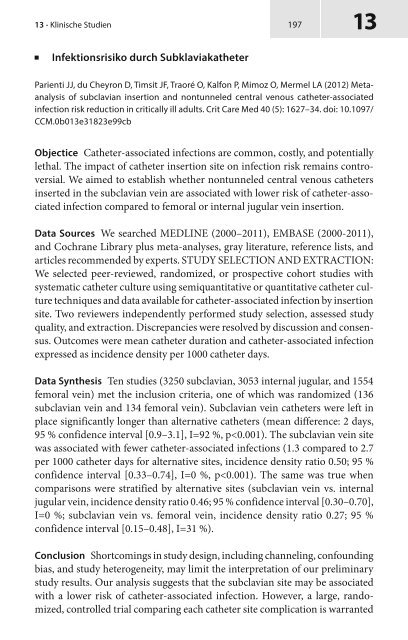Intensivmedizin Fragen und Antworten
Erfolgreiche ePaper selbst erstellen
Machen Sie aus Ihren PDF Publikationen ein blätterbares Flipbook mit unserer einzigartigen Google optimierten e-Paper Software.
13 · Klinische Studien<br />
jInfektionsrisiko durch Subklaviakatheter<br />
197<br />
13<br />
Parienti JJ, du Cheyron D, Timsit JF, Traoré O, Kalfon P, Mimoz O, Mermel LA (2012) Metaanalysis<br />
of subclavian insertion and nontunneled central venous catheter-associated<br />
infection risk reduction in critically ill adults. Crit Care Med 40 (5): 1627–34. doi: 10.1097/<br />
CCM.0b013e31823e99cb<br />
Objectice Catheter-associated infections are common, costly, and potentially<br />
lethal. The impact of catheter insertion site on infection risk remains controversial.<br />
We aimed to establish whether nontunneled central venous catheters<br />
inserted in the subclavian vein are associated with lower risk of catheter-associated<br />
infection compared to femoral or internal jugular vein insertion.<br />
Data Sources We searched MEDLINE (2000–2011), EMBASE (2000-2011),<br />
and Cochrane Library plus meta-analyses, gray literature, reference lists, and<br />
articles recommended by experts. STUDY SELECTION AND EXTRACTION:<br />
We selected peer-reviewed, randomized, or prospective cohort studies with<br />
systematic catheter culture using semiquantitative or quantitative catheter culture<br />
techniques and data available for catheter-associated infection by insertion<br />
site. Two reviewers independently performed study selection, assessed study<br />
quality, and extraction. Discrepancies were resolved by discussion and consensus.<br />
Outcomes were mean catheter duration and catheter-associated infection<br />
expressed as incidence density per 1000 catheter days.<br />
Data Synthesis Ten studies (3250 subclavian, 3053 internal jugular, and 1554<br />
femoral vein) met the inclusion criteria, one of which was randomized (136<br />
subclavian vein and 134 femoral vein). Subclavian vein catheters were left in<br />
place significantly longer than alternative catheters (mean difference: 2 days,<br />
95 % confidence interval [0.9–3.1], I=92 %, p


